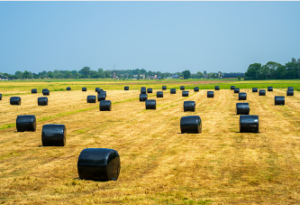Silage wrap is a product that farmers use to keep hay and other green fodder fresh. It helps preserve the nutrients in the crop and saves preservation costs.
 A silage wrap comprises several layers that protect the bale from the elements, including moisture and heat. It also features an oxygen barrier that prevents spoilage.
A silage wrap comprises several layers that protect the bale from the elements, including moisture and heat. It also features an oxygen barrier that prevents spoilage.
It Prevents Moisture From Penetrating
The purpose of silage wrap is to keep the moisture from penetrating the bales so that the nutrients can stay in the feed. It can help prevent the loss of valuable nutrients and make the feeding process more efficient.
Several factors affect the quality of a bale, including its moisture level, cut stage and bale density. The optimum moisture level for a bale is 45-55%, but this can vary from farm to farm. Moisture levels that are too high will cause clostridial fermentation and higher levels of ammonia and butyric acid.
It can lead to poor ensiling results. The nutrient profile of forage is determined by the number of fermentable carbohydrates it contains, which can be affected by the cutting stage. Coarse, stemmy and overly mature forages are unsuitable for ensiling as they have less available sugars to complete the fermentation process.
The lactic acid level is also an essential factor that can influence the quality of a bale. Bales with a low lactic acid content may not need to be wrapped but will still benefit from being kept dry to prevent spoilage.
In addition to ensuring the correct moisture level, a good bale wrap will also keep oxygen from penetrating the silage. It will ensure that the lactic acid produced during fermentation can reach the PH levels required to inhibit microbial growth and preserve nutrients.
Another way that a bale can be compromised is by the damage it may be subjected to during transport or storage. It can result in air escaping from the bale, which will not only cause mould and rot to occur but will also reduce the nutrient content of the silage.
A bale wrap will also help to protect the hay from being damaged by other animals on the farm. It can be particularly important if cattle are present as this can increase the risk of them chewing through the plastic and breaking it, resulting in oxygen escaping from the bale.
It Prevents Heat Build-up
Silage wrap protects bales from heat build-up during storage. In addition, it prevents hay and straw from drying out prematurely, reducing the silage quality and increasing dry matter losses.
The film also helps keep the bales’ moisture level uniform, critical for good fermentation and storage stability. The wrap should be applied at 50 to 60 per cent moisture, preferably within two hours of baling. It should be wrapped as tight as possible (adhesive side toward the bale), so the film is stretched evenly on each bale.
When bales are stored in bags, sealing them as packed and checking their integrity every two weeks during storage is essential. Leaks can create large pockets of spoiled forage. Ensure bags are placed on sites with good drainage, preferably on concrete or asphalt pads.
Proper agronomic practices and additives help prevent fungal infections of hay and straw in silos. Rotating crop varieties to reduce the risk of carryover of diseases from one year to the next, keeping silo air voids dry, and eliminating oxygen quickly and entirely after harvest are all ways to control fungal growth in ensiled crops.
Microbial inoculants are a popular silage additive. These organisms can enhance lactic acid production, speeding fermentation and decreasing dry matter loss. Lactic acid bacteria are the most common microbial inoculant, but enzymes that break down fibre may also be added to the mixture.
It Prevents Punctures
Silage wrap is a type of film that farmers use to store silage bales. It helps to prevent punctures and reduces the risk of spoilage. It can also be a great way to protect your fodder from animals looking for it.
There are many different types of silage wrap available on the market. Each one will have its unique features. For example, some are transparent, some are opaque, and some have UV stabilisers.
The most common type of silage wrap is a blown film that expands and contracts with changing temperatures. It allows it to fit tighter around the bale and prevent leakage.
Some types of silage wrap are made from five or more layers and include an oxygen barrier to prevent oxygen flow into your bales. It will help to decrease the amount of oxygen in your fodder, which will help to prevent bacterial and fungal growth.
When wrapping your haylage, it is essential to cover it as soon as possible after baling. The longer you wait, the more oxygen will be in your haylage, and this will cause it to ferment. Moving the haylage during the fermentation process will also be more challenging.
It is recommended that you wrap the haylage close to where it will be stored to reduce handling and damage. You should also avoid moving the haylage during the fermentation process, which can lead to the bursting of the haylage.
